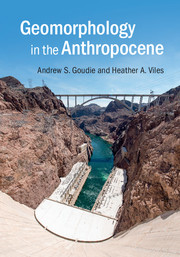20 results
8 - Aeolian Processes and Forms in the Anthropocene
-
- Book:
- Geomorphology in the Anthropocene
- Published online:
- 20 October 2016
- Print publication:
- 10 October 2016, pp 179-192
-
- Chapter
- Export citation
9 - Coastal Processes and Forms in the Anthropocene
-
- Book:
- Geomorphology in the Anthropocene
- Published online:
- 20 October 2016
- Print publication:
- 10 October 2016, pp 193-222
-
- Chapter
- Export citation
7 - Fluvial Processes and Forms in the Anthropocene
-
- Book:
- Geomorphology in the Anthropocene
- Published online:
- 20 October 2016
- Print publication:
- 10 October 2016, pp 130-178
-
- Chapter
- Export citation
4 - Subsidence in the Anthropocene
-
- Book:
- Geomorphology in the Anthropocene
- Published online:
- 20 October 2016
- Print publication:
- 10 October 2016, pp 57-70
-
- Chapter
- Export citation
11 - Conclusions on the Relationships Between Geomorphology and the Anthropocene
-
- Book:
- Geomorphology in the Anthropocene
- Published online:
- 20 October 2016
- Print publication:
- 10 October 2016, pp 234-250
-
- Chapter
- Export citation
6 - Hillslope Processes in the Anthropocene
-
- Book:
- Geomorphology in the Anthropocene
- Published online:
- 20 October 2016
- Print publication:
- 10 October 2016, pp 87-129
-
- Chapter
- Export citation
Copyright page
-
- Book:
- Geomorphology in the Anthropocene
- Published online:
- 20 October 2016
- Print publication:
- 10 October 2016, pp iv-iv
-
- Chapter
- Export citation
Index
-
- Book:
- Geomorphology in the Anthropocene
- Published online:
- 20 October 2016
- Print publication:
- 10 October 2016, pp 319-324
-
- Chapter
- Export citation
3 - Construction and Excavation
-
- Book:
- Geomorphology in the Anthropocene
- Published online:
- 20 October 2016
- Print publication:
- 10 October 2016, pp 31-56
-
- Chapter
- Export citation
Contents
-
- Book:
- Geomorphology in the Anthropocene
- Published online:
- 20 October 2016
- Print publication:
- 10 October 2016, pp v-viii
-
- Chapter
- Export citation
10 - Cryospheric Processes and Forms in the Anthropocene
-
- Book:
- Geomorphology in the Anthropocene
- Published online:
- 20 October 2016
- Print publication:
- 10 October 2016, pp 223-233
-
- Chapter
- Export citation
1 - Introduction to the Anthropocene and Anthropogeomorphology
-
- Book:
- Geomorphology in the Anthropocene
- Published online:
- 20 October 2016
- Print publication:
- 10 October 2016, pp 1-14
-
- Chapter
- Export citation
References
-
- Book:
- Geomorphology in the Anthropocene
- Published online:
- 20 October 2016
- Print publication:
- 10 October 2016, pp 251-318
-
- Chapter
- Export citation

Geomorphology in the Anthropocene
-
- Published online:
- 20 October 2016
- Print publication:
- 10 October 2016
Acknowledgements
-
- Book:
- Geomorphology in the Anthropocene
- Published online:
- 20 October 2016
- Print publication:
- 10 October 2016, pp ix-x
-
- Chapter
- Export citation
Reviews
-
- Book:
- Geomorphology in the Anthropocene
- Published online:
- 20 October 2016
- Print publication:
- 10 October 2016, pp ii-ii
-
- Chapter
- Export citation
2 - Drivers of Anthropogeomorphological Change
-
- Book:
- Geomorphology in the Anthropocene
- Published online:
- 20 October 2016
- Print publication:
- 10 October 2016, pp 15-30
-
- Chapter
- Export citation
5 - Weathering Processes in the Anthropocene
-
- Book:
- Geomorphology in the Anthropocene
- Published online:
- 20 October 2016
- Print publication:
- 10 October 2016, pp 71-86
-
- Chapter
- Export citation
12 - Weathering hazards
-
-
- Book:
- Geomorphological Hazards and Disaster Prevention
- Published online:
- 10 January 2011
- Print publication:
- 04 March 2010, pp 145-160
-
- Chapter
- Export citation
The Effects of Air Pollution on the Built EnvironmentEDITED BY PETER BRIMBLECOMBE xix + 428 pp., 89 figs, 23.5 × 16 × 2.5 cm, ISBN 1 86094 291 1 hardback, GB£ 26.00, London, UK: Imperial College Press, 2003
-
- Journal:
- Environmental Conservation / Volume 31 / Issue 2 / June 2004
- Published online by Cambridge University Press:
- 27 July 2004, pp. 175-176
-
- Article
- Export citation



